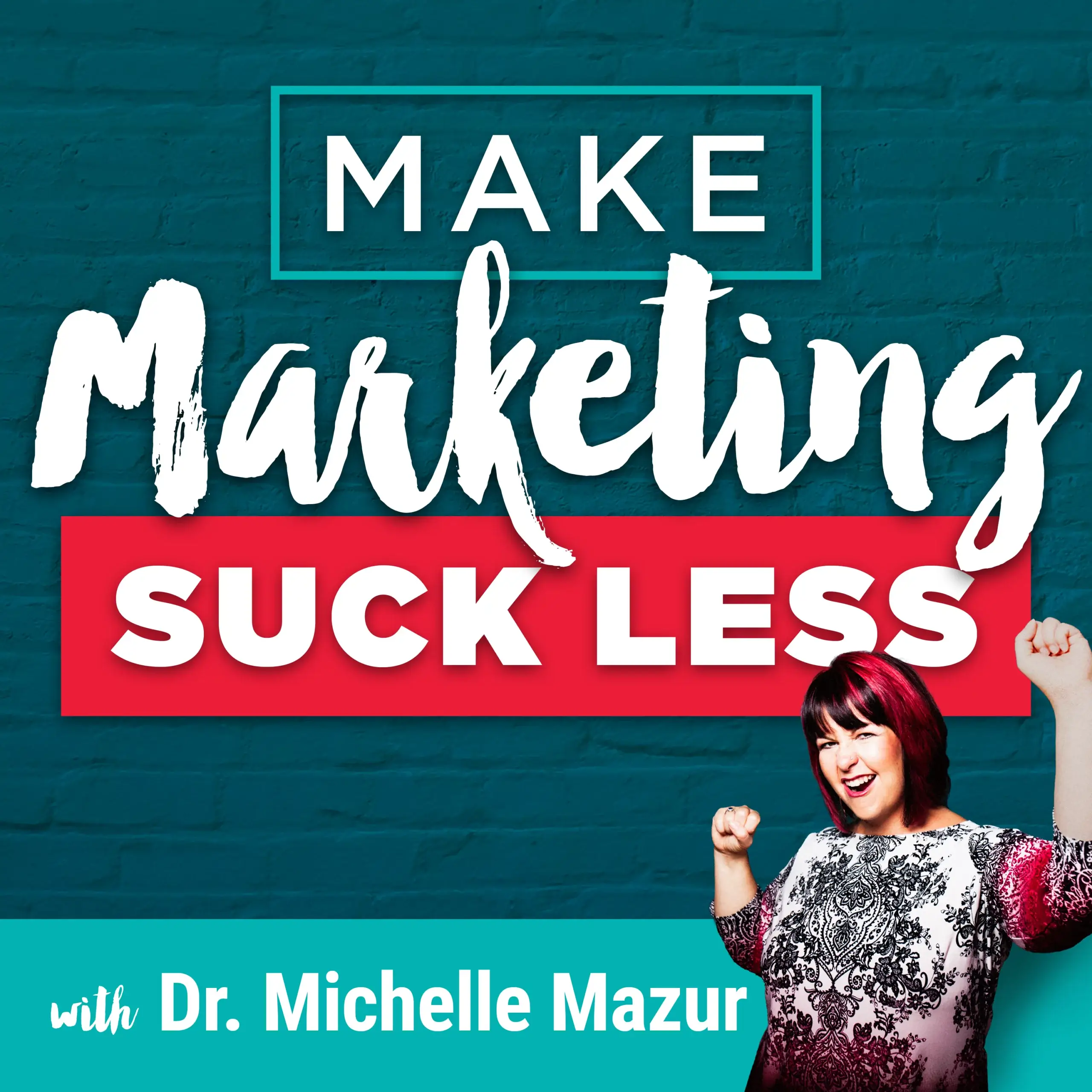Make Marketing Suck Less
Building an Argument: How to Get Past the Manipulation Tactics
By Michelle Mazur > February 1, 2022
Filed Under Podcast

Pull a hoard of drooling, slobbering, fervent buyers willing to buy everything you have to offer!
Yeah. That’s a real headline from a real sales page.
Ick.
But it reminded me of a question from a member of my email community that asked me, what will replace manipulative, privilege-based marketing in years to come?
And the short answer is that we, as business owners, have to learn how to persuade in a different way.
If we’re are going to break free from manipulative marketing, we have to encourage critical thinking in our buyers and prospective clients. And the way that we encourage critical thinking is by building an argument for our work.
When you do this, not everyone is going to buy into the argument that you’re building. You will hear no. And that’s okay, because that means that client wasn’t right for you.
If they’re not buying into your argument, it’s good to hear no! You should be hearing no! Even though it’s uncomfortable and it hurts.
But what does building an argument even mean? What does that look like?
That’s what we’re diving into today.
In This Episode:
- The two foundational paths to persuasion
- Why your unique perspective and point of view are a prerequisite for making an argument
- Five steps to building an argument for your work
Learn more about Michelle Mazur:
Listen on your favorite podcast player or read the Transcript below
(00:00): Pull a hoard of drooling, slobbering, fervent buyers willing to buy everything you have to offer. Yeah, that's a real headline from a real sales page. It reminded me of this question from a member of my email community, Ed. He asks me, "If you could paint a picture of what will replace manipulative, privilege based marketing in years to come, what would it be?" (00:30): And I love this question because it takes me back to my college days. But the answer is, we have to learn as business owners how to persuade in a different way. We have to learn how to build an argument for our work. But what does that even mean? What does it look like? That's what we are diving into on this episode of the Rebel Uprising podcast. So, let's do this. (01:11): You're listening to the Rebel Uprising podcast. This podcast is dedicated to helping passionate business owners become recognized leaders who make more money and impact the world by turning their messy, complicated ideas into thriving thought leadership businesses. I'm your host, Dr. Michelle Maser, and I'll be your no BS guide in the art of building a business that gets noticed. Each week, I share strategies, tools, and insights on how to turn your complicated ideas into great messaging and solid business structures. Are you ready to create an uprising in your industry? Let's do this. (01:53): I'm sure you've seen messaging around how you can rejection-proof your business with these persuasive hacks or a business owner promising you that you will never hear no again if you just use these swipe templates that are usually laden with a lot of psychological tricks and NLP. And let's be honest, promises like that one, "Oh, let's rejection proof my business. I never have to hear no again. Oh, my gosh. That feels so amazing." It's hard to be rejected, and it's really hard when you believe in what you do and you're passionate about it and you know how it can help people. It's hard to hear no. So it's so enticing when we hear that we can rejection proof our business. (02:50): However, rejection proofing, persuasion, hacks, the use of social triggers, all of that is manipulative marketing and sales tactics. If we are going to break free from manipulative marketing, manipulative sales, we have to encourage critical thinking in our buyers and perspective clients. And the way that we encourage critical thinking is by building an argument for your work. When we do this, not everyone's going to buy into the argument that your building, so you will hear no, and that's okay, because that means that client wasn't right for you, if they're not buying into your argument for your work. (03:42): It's good to hear no. You should be hearing no, even though it's uncomfortable and it hurts. And recently, I've been talking to my clients a lot about building an argument. When one of them said to me, "Oh, my homepage, it's an argument of why they should stick around on my website and what they should do next. My sales page is an argument for my program. My marketing is an argument for why they should pay attention or give a crap about what you're doing." (04:19): So, yes it is. It's all an argument. And that is the alternative route to persuasion that we need to be doing in our marketing and sales, in past episodes, especially ones on bro marketing, I have talked about two psychological theorists named Petty and Cacioppo. Their theory of the elaboration likelihood model. This is from 1964, so it's old school, but it is still a foundational piece of the psychology of persuasion and communication. And so, in this, they talk about that there are these two paths to persuasion. One is using all of the social cues, the NLP, the FOMO, the fear, in order to get people to make a decision. And this path, it's like when we can't critically think, or you don't want your people to critically think, we go down that path. (05:16): The second path is about building an argument. It's about logic and reasoning and touching on people's emotion. So, how can you start building an argument for your work? So, this is a high level overview and hey, if you were a college debater or high school debater, like I was, this might seem somewhat familiar to you. Because it's really how, as a debater, I would build a case to debate. (05:52): Okay. So, the first thing I want to talk about is that there is a prerequisite to going down this path. The prerequisite is that you are going to have to take a stand and have a unique point of view. When you make an argument for your work, that copy, what you're saying in your marketing, is going to be completely unique to you. It can't exist on another sales page because no one can argue for your work the way that you can. (06:29): And what we see in the marketplace right now is all of the meh messages that I talked about in the final episode of 2021, that vague language, the promises that people really can't keep, like, "Oh, you're going to make this much money in this amount of time." They can't actually make those promises. And they definitely cannot keep those promises. So, you have to get more specific, rely less on the common messaging that we see everywhere. And that is going to make you take a stand, have a viewpoint, and basically put a flag in the ground to say, "This is what my work is all about." So, that is the prerequisite. (07:21): Hey, if you are ready to build that argument for your work and powerfully and persuasively communicate what your business does in your marketing, sales and copy, that's exactly what you and I can do together in the Three Word Rebellion Messaging Intensive. In this 90 day, one-on-one program, we build out comprehensive messaging that positions your work with the Three Word Rebellion and builds the argument for your business that turns strangers on the internet into people who are one team to work with you. If you're ready to see if this is the right next move for your business, go to 3wrcall.com. That's the number three, wrcall.com, and request a chat with me. I'd love to talk with you and see if this is the right step for your business to get the word out about the amazing work you're doing. Now, back to the show. (08:26): So, step one of building an argument is answering the question, "Why does the status quo suck for your potential clients and customers?" Here's the deal. People don't change. People don't make a decision to do something differently if their current reality is working for them perfectly. Like if they don't perceive they have a problem, they're not having a struggle, they're not going to make a change. (08:56): So, part of your job in building an argument is really understanding your people and what are they struggling with? Like what's going on inside of their brains? What are they thinking, feeling, doing, saying? What have they tried before that hasn't worked? That is all about acknowledging where they are and their struggle. It's not about pressing on pain points. It's really about acknowledging. (09:24): For example, in my work, I know my clients are usually great at sales, could close sales all day long. They just can't get people into the sales conversation or into their sales process, which is a marketing problem. And they have tried lots of different things, lots of different programs, but nothing has worked. And so, for most of them, they have given up and they rely on word of mouth, or they're still consistent, but they're just putting in way more effort. (09:56): I know all of that, based on the client conversations I've had. So, that is the basis of my argument and saying, "Hey, the status quo sucks for you, and you are struggling, and there is a reason why for that." So, it's about acknowledging what's happening, empathizing with it, but not making them feel like shit about it. We're not pressing on pain points. You're not kicking someone in a broken leg. You're saying, "Hey, I see this going on for you." (10:25): And the reaction you want from them is like, "Oh, she's in my head. She totally gets me." That's what we want our marketing and our copy to do, because then we can move to step number two. And this is one of the things I do with my clients in the messaging intensive, is I look for the villain. I name the villain, which is the outside force that is causing these problems. So, who is that villain in the story? And guess what? It's never your client. Never, ever, ever your client. But it is something else that lives outside of them. (11:04): So, for example, one of my villains is bro marketing and manipulative marketing and sales tactics. Because I know my people do not align with that. They have tried it. It has made them feel like crap and it hasn't worked. So, that is my villain, the villain that this is how we're taught to market and sell. We're not taught to build an argument. We're taught to manipulate people. So, just name it, call a thing a thing. (11:31): So, then, step number three in this is answering the question, what slays the villain? What is your unique solution? What change are you trying to create? Now, if you've read the Three Word Rebellion book, you're probably like, "Wait a minute. Michelle asked in the book, 'What am I rebelling against? What about the status quo isn't working or isn't right? And what change am I creating?'" Yes. I've been teaching you to build an argument all along. Well done. (12:00): But for this, this is about really thinking about what is your unique solution? What is your unique framework, and why does it slay the villain? For me, I know that the Three Word Rebellion framework is designed to slay the villain because I am teaching my people how to build an argument for their work. I am taking them down the second path of persuasion, where we're not relying on rejection proofing your business and all those skeezy sales and manipulative tactics. No, we're thinking about how can I build this argument out? And that will always slay the villain. Because if you can advocate for your work, you can slay that villain. (12:54): Okay. The fourth step. Now this is probably the easiest step, is how does all of this work? So, this is where you detail your framework, you detail your process, and you can talk about the logistics. So, if they're going on this quest with you to slay the villain, what can they expect? For me, when I'm on a sales conversation or even doing a podcast episode, I describe the phases that I move people through to slay this villain, to build this argument for their work. And that doesn't change. I have the five phases that I move people through, audience deep dive, three word rebellion, client decision journey, signature stories, marketing strategy. That's what it takes to overcome the villain. And then I can describe what it looks like to go on that journey. (13:46): And then, the final step, step number five. This is really about talking about what can people expect? What is possible? I call this the reason to believe, which came from my market research days. But what are the benefits of doing this work? And I just don't mean the hard and fast results, because we have been trained in this industry that we should always be promoting the tangible results. Like, look at how much money is so and so made. (14:19): But after you see how much money everybody makes, it gets a little old. You're like, "Okay, all of these programs make people money. Great." But being more nuanced, like what is possible for your people. What is possible? I always like to think about the tangible and the intangible results. Because there's the tangible stuff, like okay. My clients, for instance, have an easier time getting clients, because people are interested and intrigued in their work. They also write books, get on podcasts, get speaking opportunities, get a chance to share their message. (15:01): But then there's a lot of intangible stuff that happens. They end up having courage and confidence to go out there and share their message. They have clarity. They know what to say in their marketing and sales. They're wasting less time with marketing because they do know what to say. And they're like, "Ah, this works. I'm going to let my freak flag fly and take a stand for this in my message." So, what is it? What is possible for your clients? That is a part of your argument. (15:32): Then, it's all about compiling this argument so that it makes sense in a marketing context versus a sales page context versus your homepage or what you're going to say in podcast interviews. So, that is how we start building an argument for our work. It it's all about messaging. It's all about understanding your people, having a unique point of view, getting people's attention and willing to take the risk to stand out and advocate for what it is you do. And that is what I want for you. And that how we slay the bro marketing, manipulative marketing sales dragon, is by being able to build this argument for our work. (16:23): So, for next time, what I would love for you to do is just to take one of these steps. I would recommend step number one, your client and what they're saying and where they currently are. And start thinking about gathering that information, so you can build your argument. (16:42): Now, stay tuned for next week because I am bringing you an interview that I am super excited about. I'm talking to a person who is in a super competitive industry, where if you don't advocate for your work, if you don't have a great pitch for your work, it just dies on the vine. I am speaking to a two time Emmy award winning show runner David Noll from the series Chopped. So, I can't wait for you to hear this conversation because it has so many implications for business and for advocating for your work. (17:25): Thank you for listening all the way to the end of the show. Your support means the world to me. Did you know, the Rebel Uprising Podcast has a quiz that can help you pinpoint for one way to build an audience of super fans while staying true to your unique personality? We do, and it's called What's Your Rebel Roadmap To Exponential Impact And Influence? And you can take it at therebelquiz.com. (17:48): If you are loving the podcast, do us a favor. Rate and leave us a quick five star review wherever you listen to your podcasts. It helps more people like you find the show. Until next week, remember, your ideas matter. And now, get back out there and cause an uprising in your industry. You got this.
Enter your name and email address below and I'll send you periodic updates about the podcast.
Sign up to receive email updates
Create Your One-of-a-Kind Message
Your 3 Word Rebellion is the Key to Growing Your Business & Impact






